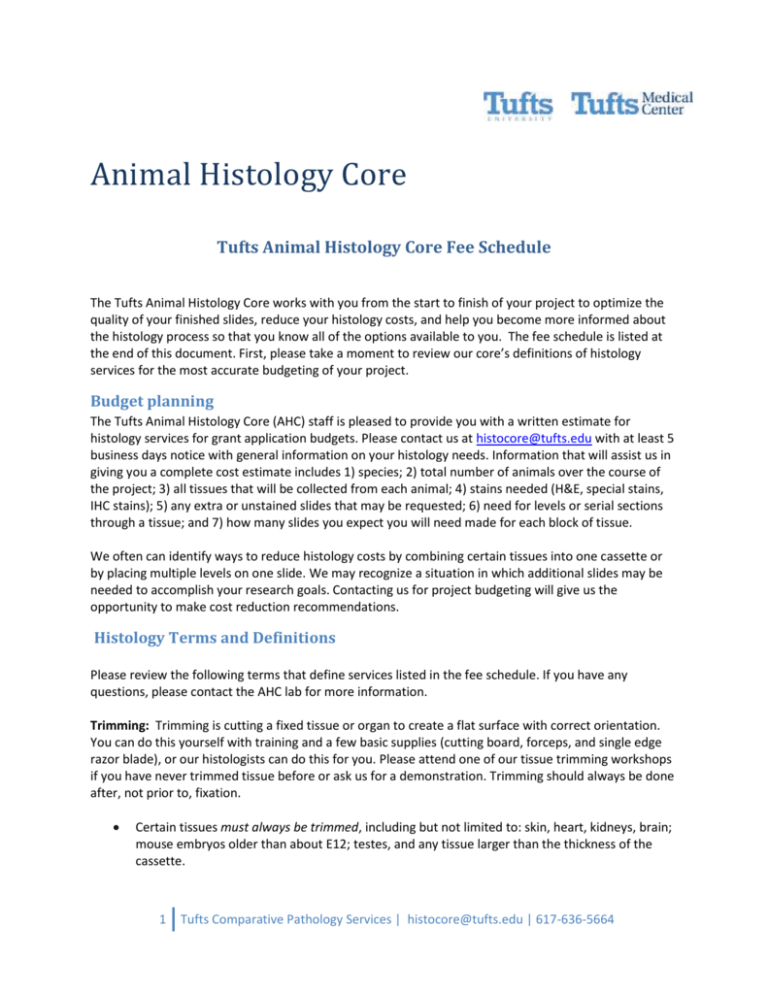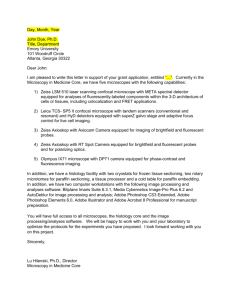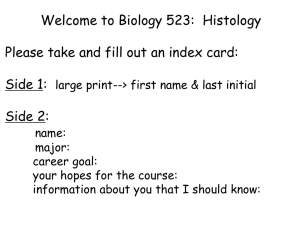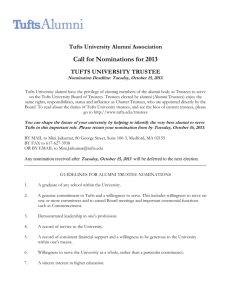Tufts Animal Histology Core Fee Schedule
advertisement

Animal Histology Core Tufts Animal Histology Core Fee Schedule The Tufts Animal Histology Core works with you from the start to finish of your project to optimize the quality of your finished slides, reduce your histology costs, and help you become more informed about the histology process so that you know all of the options available to you. The fee schedule is listed at the end of this document. First, please take a moment to review our core’s definitions of histology services for the most accurate budgeting of your project. Budget planning The Tufts Animal Histology Core (AHC) staff is pleased to provide you with a written estimate for histology services for grant application budgets. Please contact us at histocore@tufts.edu with at least 5 business days notice with general information on your histology needs. Information that will assist us in giving you a complete cost estimate includes 1) species; 2) total number of animals over the course of the project; 3) all tissues that will be collected from each animal; 4) stains needed (H&E, special stains, IHC stains); 5) any extra or unstained slides that may be requested; 6) need for levels or serial sections through a tissue; and 7) how many slides you expect you will need made for each block of tissue. We often can identify ways to reduce histology costs by combining certain tissues into one cassette or by placing multiple levels on one slide. We may recognize a situation in which additional slides may be needed to accomplish your research goals. Contacting us for project budgeting will give us the opportunity to make cost reduction recommendations. Histology Terms and Definitions Please review the following terms that define services listed in the fee schedule. If you have any questions, please contact the AHC lab for more information. Trimming: Trimming is cutting a fixed tissue or organ to create a flat surface with correct orientation. You can do this yourself with training and a few basic supplies (cutting board, forceps, and single edge razor blade), or our histologists can do this for you. Please attend one of our tissue trimming workshops if you have never trimmed tissue before or ask us for a demonstration. Trimming should always be done after, not prior to, fixation. Certain tissues must always be trimmed, including but not limited to: skin, heart, kidneys, brain; mouse embryos older than about E12; testes, and any tissue larger than the thickness of the cassette. 1 Tufts Comparative Pathology Services | histocore@tufts.edu | 617-636-5664 Other tissues or organs are often trimmed for optimal examination. Trimming is recommended but may not be required: e.g. tumors, liver, mouse lungs, intestines. Some tissues or organs need not be trimmed for routine screening: eg. rodent eyes, pancreas, ovary, rodent lymph nodes, or mouse uterus. However, there are instances in which even these organs might need to be trimmed. Standard trimming of rodent tissues will be done by our histologists based on the RENI guidelines http://reni.item.fraunhofer.de/reni/trimming/ with some adaptations. These published trimming recommendations are also helpful to follow if you trim the tissues yourself. Custom trimming should be done when 1) trying to locate or demonstrate a very specific anatomic structure of an organ not generally captured using standard trim guidelines; 2) capturing lesions in areas that would normally fall outside of a standard trimming section; and 3) whenever trimming is requested at custom landmarks by project design. Cassetting: Taking trimmed or untrimmed tissue and orienting it in a tissue cassette to the area of interest. All tissues for paraffin embedding must be cassetted. You can cassette with training and a few basic supplies (histology cassettes, forceps) or our histologist can do this for you. If you bring samples to our core in cassettes, we will assume that they have been trimmed and are ready to be processed unless you tell us otherwise. It is much more difficult to trim tissue after it has been processed, so for best quality and fastest turn-around time, you must let us know if you submit untrimmed tissues in cassettes. Decalcification: Bone and other mineralized tissue must be decalcified prior to routine paraffin embedding and sectioning. The AHC routinely uses 8.8% formic acid to decalcify specimens. Length of decalcification is dependent on size of tissue, but most mouse tissue will decalcify in 2-3 days. If another decalcification method (EDTA, HCl) is required, please contact the core. The AHC offers decalcification as a service, or you can decalcify tissues in your lab. If you have never decalcified tissue before, please consult us first for our recommendations to prevent accidental chemical “burn” of the tissue that can ruin tissue morphology. Processing: Tissue processing includes dehydration, clearing, and infiltration of the tissue with paraffin wax. This is usually accomplished on a piece of equipment called a tissue processor using programs that the lab has established for a species, tissue, or special need. Our lab uses a number of different processing schedules, optimized for different species and tissues. Tissue processing is done by our histologists unless you have access to a tissue processor in another lab. Paraffin Embedding: Tissue embedding involves carefully removing processed tissues from cassettes, placing them into a mold while maintaining their original orientation, and then filling the mold with paraffin wax. This produces a paraffin block. Embedding is done by our histologists unless you have access to an embedding station in another lab or already have embedded blocks that were previously prepared. Tissues that have been processed and embedded can remain in a block indefinitely. Paraffin blocks can be sectioned immediately or years later. If your protocol calls for a defined period of tissue fixation, you can get the tissue processed and embedded after fixation and can then hold the blocks until you determine sectioning needs later across your whole study. Sectioning: Sectioning of paraffin blocks is done using a microtome that cuts very thin sections of the paraffin-embedded tissues, which are placed on a slide. Routine thickness for paraffin sections in the 2 Tufts Comparative Pathology Services | histocore@tufts.edu | 617-636-5664 AHC is 5 microns. If you require thicker or thinner paraffin sections, please give us special instructions in the submission form. Unstained section: Slides with a paraffin section of tissue that has not been deparaffinized and has not been stained with any stains. These unstained sections can later be used in your lab for a special stain process or can be saved as “extra” slides. Note that prolonged storage of cut but unstained sections can sometimes diminish the quality of the final slides, depending on the stain to be used. If you do not plan to use the unstained sections within a few weeks, you might consider leaving the tissue in the paraffin blocks and getting the unstained sections cut closer to the time you plan to use them. Serial Section: Standard sectioning is done as a serial sectioning unless specified otherwise. Serial sectioning refers to collection of sections without any extended gaps between sections. For example, if a paraffin block contains one kidney, requesting 3 serial sections of that block would give you 3 sections of that piece of kidney that are 5 microns apart from each other. Those 3 sections will look almost identical to each other because they are so close together. You would need to order many serial sections to get significantly deeper into the block. Our histologists can often put multiple sections on one slide. The number of sections that can fit on a slide will depend on the size of the paraffin block. Ask our histologists how many sections of any given tissue they think they can put on the same slide when budgeting for the cost of serial sections. Step Sectioning: Sections can also be collected with gaps between sections. This allows for a wider range of sections but exhausts blocks sooner. For example, if a paraffin block contains one kidney, requesting 3 step sections that are 200 microns apart would give you three different sections of kidney that are far enough apart to likely look different and to show different structures. However, please note that the tissue in between the requested sections is discarded permanently, because it is all cut in a ribbon. If you need step sections but are reluctant to lose the tissue between the levels, you can request additional slides be made to keep some of the extra tissue, and these slides stored “just in case” you find you need them later. Our histologists often have tips for you to reduce your slide costs while conserving precious research tissue. Please consult with the histologists prior to tissue trimming so they can help you get the most tissue for the least cost in your final slides. H&E: Hematoxylin and eosin stain. H&E is the most commonly used routine stain in histology. Hematoxylin is a dark blue nuclear stain, and eosin is a counterstain that results in shades of pink. Paraffin sections are deparaffinized and rehydrated, stained, and then coverslipped. Special Stains: Any stains other than H&E are considered special stains. Most stains are considered category I stains but any stain involving silver or gold is considered a category II stain. For a complete list of stains offered, visit http://sites.tufts.edu/histopath/animal-histology-core/special-stains/ Frozen Sectioning: Frozen sectioning can be performed with a cryostat on submitted blocks frozen in OCT. Frozen tissue can also be embedded in OCT at the time of sectioning. Because of the varying differences in cryosectioning projects, fees are priced by histologist time. Frozen tissue gets embedded into a frozen mold, sectioned in a cryostat, sections are adhered to slides, and the slides can either be stored frozen or can be stained and coverslipped. Please note that frozen sections may have advantages over formalin fixed, paraffin-embedded (FFPE) sections in terms of antigen preservation or preservation of lipids, but FFPE sections generally have better morphology. Expect an H&E stained frozen section to not have the same quality of tissue morphology as an H&E stained FFPE section. The method of freezing 3 Tufts Comparative Pathology Services | histocore@tufts.edu | 617-636-5664 factors significantly into the final slide quality, so please consult with the histologists prior to tissue freezing if you have not done this before. Cryostat Use: A cryostat is used to make sections of frozen tissues. The AHC cryostat is available to Tufts investigators who have demonstrated proficiency with cryosectioning. Cryostat training is also available to Tufts investigators. We are unable to offer cryostat usage to investigators outside of Tufts at this time. Training and Technical Assistance: AHC histologists offer training in cryostat use, microtomy, staining or assistance in setting up new histology labs. We also offer services in tissue collection and preparation. IHC: The AHC validated antibody list and IHC policy can be found at: http://sites.tufts.edu/histopath/animal-histology-core/immunohistochemistry/ . Please contact the core if you wish to request an antibody not yet on the list. Pathology Services: A veterinary pathologist is available for consultation or for research pathology services. If you plan to consult the pathologist, please contact her at lauren.richey@tufts.edu prior to tissue collection. Summary For full service histology, submit fixed or frozen tissues to the Animal Histology Core, and the AHC staff will trim, cassette, process, embed, section, stain, and coverslip your slides as appropriate. You can bring your own slide box or slide flat or purchase one from the core. Use the following fee schedule as a guide to determining the expected costs. 4 Tufts Comparative Pathology Services | histocore@tufts.edu | 617-636-5664 Tufts Animal Histology Core Fee Schedule effective through June 30, 2015 Service Tufts/TMC External Academic External Corporate Routine Sections from Fixed Tissues Standard trim and cassette (trim fixed tissues and correctly orient them into a cassette) Process, embed (from cassette to paraffin block) Process, embed, section, H&E (cassette to first H&E stained slide) Process, embed, cut, unstained (cassette to first unstained slide) Trim, cassette, process, embed, section, H&E (fixed tissue to first H&E stained slide) H&E section only (an H&E slide cut from a paraffin block or duplicate H&E slides billed after the first section) Unstained section (each unstained slide from a provided paraffin-embedded block or duplicate unstained slides) $2.00/cassette $2.50 $3.30 $5.00/block $6.25 $8.25 $10.00/H&E slide $12.50 $16.50 $8.00/unstained slide $10.00 $13.20 $12.00/H&E slide $15.00 $19.80 $5.00/H&E slide $6.25 $8.25 $3.00/unstained slide $3.75 $4.95 $2.00 additional charge per block plus cost of H&E slides $2.50 $3.30 $4.00/cassette $5.00 $6.60 Category I Stain(s) (each slide) $10.00/slide plus cost of making the unstained section $12.50 $16.50 Category II Stain(s) (Silver Stains) (each slide) $15.00/slide plus cost of making the unstained section $18.75 $24.75 $6.00/frozen mold $7.50 $9.90 Step Sectioning (specify # sections and the depth of each step) Decalcification (per cassette) Special Stains (Request Stain List) (Additional fee for sectioning) Frozen Sections Frozen: embed only (per frozen mold) 5 Tufts Comparative Pathology Services | histocore@tufts.edu | 617-636-5664 Service Tufts/TMC External Academic External Corporate Frozen- embed, section (fresh tissue to one unstained slide) $42/hr + Supplies $52.50/hr $70/hr Frozen H&E Stain $2.00/slide plus cost of making unstained frozen section $2.50 $3.30 $10.00/hour N/A N/A $50.00/hr $62.50 $82.50 $42.00/hr $52.50/hr $70/hr IHC stain (study tissue + positive control) using an antibody on our list of validated antibodies $25.50/slide $31.88/slide $42.08/slide IHC stain of an antibody with potential use by several researchers that you request and we add to our list of validated antibodies (we purchase the antibody and optimize the protocol) $25.50/slide $31.88/slide $42.08/slide Equipment-Unassisted Use Cryostat Use (Supplies purchased separately. Initial equipment training is required prior to unassisted use.) Histology Training and Consultation Cryostat Training (Supplies can be purchased separately) Technical Assistance (trimming, embedding instructions, etc) Immunohistochemistry IHC optimization of an antibody that you provide. Optimization is required before staining experimental slides. IHC optimization of an antibody that we purchase and develop the protocol for. Note that if your requested antibody will be an IHC that will be frequently ordered by your lab or by other labs, you will not be charged this optimization fee, but only the per slide fee listed above. Supplies 25 Count slide box 50 Count slide box 6 $42/hour tech time for $52.50/hour optimization prior to staining experimental Tech time ($42/hr) Tech slides. up to max 8 hours time($52.50/hr) plus cost of up to a max of antibody prior to 8 hours plus staining cost of experimental antibody prior slides to staining experimental slides $5.25/box $6.56 $6.50/box 70/hr Tech time($70/hr) up to a max of 8 hours plus cost of antibody prior to staining experimental $8.66 slides $8.13 Tufts Comparative Pathology Services | histocore@tufts.edu | 617-636-5664 $10.73 Service 100 Count slide box Tufts/TMC External Academic External Corporate $8.00/box $10.00 $13.20 $6.50/folder $8.13 $10.73 $0.20/cassette $0.25 $0.33 Pathologist services (slide interpretation and reports, photomicroscopy, consultation, training, necropsy) $150/hr $187.50/hr $250 Pathology Technician services (necropsy, sample collection, gross reports) $42.00/hr $52.50/hr $70/hr 20 Count slide folder Standard Cassette Pathology Services V08/05/14 7 Tufts Comparative Pathology Services | histocore@tufts.edu | 617-636-5664





